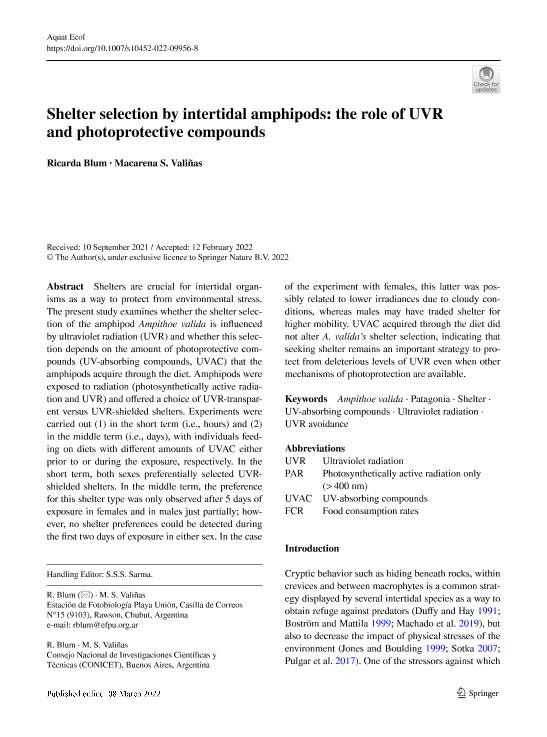Artículo
Shelter selection by intertidal amphipods: the role of UVR and photoprotective compounds
Fecha de publicación:
12/2022
Editorial:
Springer
Revista:
Aquatic Ecology
ISSN:
1386-2588
Idioma:
Inglés
Tipo de recurso:
Artículo publicado
Clasificación temática:
Resumen
Shelters are crucial for intertidal organisms as a way to protect from environmental stress. The present study examines whether the shelter selection of the amphipod Ampithoe valida is influenced by ultraviolet radiation (UVR) and whether this selection depends on the amount of photoprotective compounds (UV-absorbing compounds, UVAC) that the amphipods acquire through the diet. Amphipods were exposed to radiation (photosynthetically active radiation and UVR) and offered a choice of UVR-transparent versus UVR-shielded shelters. Experiments were carried out (1) in the short term (i.e., hours) and (2) in the middle term (i.e., days), with individuals feeding on diets with different amounts of UVAC either prior to or during the exposure, respectively. In the short term, both sexes preferentially selected UVR-shielded shelters. In the middle term, the preference for this shelter type was only observed after 5 days of exposure in females and in males just partially; however, no shelter preferences could be detected during the first two days of exposure in either sex. In the case of the experiment with females, this latter was possibly related to lower irradiances due to cloudy conditions, whereas males may have traded shelter for higher mobility. UVAC acquired through the diet did not alter A. valida’s shelter selection, indicating that seeking shelter remains an important strategy to protect from deleterious levels of UVR even when other mechanisms of photoprotection are available.
Archivos asociados
Licencia
Identificadores
Colecciones
Articulos(SEDE CENTRAL)
Articulos de SEDE CENTRAL
Articulos de SEDE CENTRAL
Citación
Blum, Ricarda; Valiñas, Macarena Soledad; Shelter selection by intertidal amphipods: the role of UVR and photoprotective compounds; Springer; Aquatic Ecology; 56; 4; 12-2022; 1055-1067
Compartir
Altmétricas




